MAIN ACHIEVEMENTS 2016
Theme 8.1. Electron Phenomena and Quantum Transport in Strongly-Correlated Metallic, Semiconducting and Hybrid Systems
Section II. "Physical sciences", subsection 8. "Actual problems of condensed matter physics, including quantum macrophycics, mezoscopy, nanostructure physics, spintronics, superconductivity". Programs of fundamental scientific researches for state academies of sciences in years 2013-2020
1. Direct Observation of Magnetic Flux Structure in EuFe2(As1-x,Px)2 Ferromagnetic Superconductors.
The structure of a magnetic flux on the surface of EuFe2(As1-xPx)2 single crystals with phosphorus content of 10.0-10.5 at.% has been studied by the methods of low-temperature magnetic force microscopy and ferromagnetic nanoparticle decoration. A magnetic domain structure has been discovered in a bulk superconductor with a critical temperature Tsc=22K under cooling in a zero magnetic field below the temperature of ferromagnetic transition TC=18K for the first time. The magnetic domain structure unambiguously indicates the coexistence of superconducting and ferromagnetic ordering at the atomic level.



L.Ya. Vinnikov, V.S. Stolyarov
2. Study of Metastable High-Temperature Superconductivity of Al/Al2O3 Interfaces.
Superconductivity has been discovered at temperature ~65 K in the samples based on metal aluminum foils subjected to surface oxidation under special conditions. Superconductivity of the samples occurs in a boundary (interface) layer located between the phases of aluminum metal and its oxide, Al2O3. It has been determined that the investigated superconductors are unstable under normal conditions, while storing the samples at liquid nitrogen temperature (77 K) permits to retain their superconducting properties for quite a long time [1].
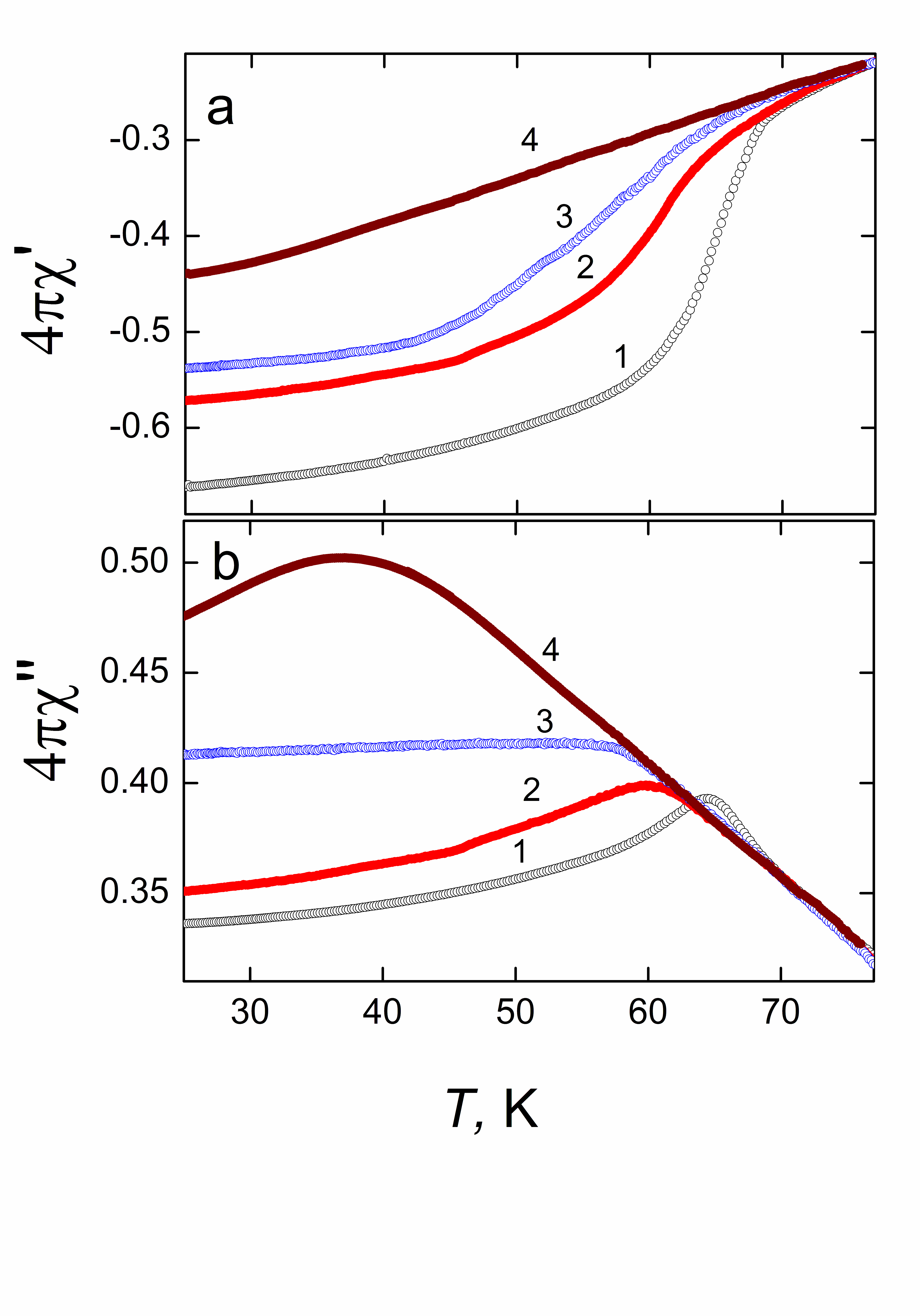
Fig.1. Temperature dependences of the real (a) and imaginary (b) parts of dynamic magnetic susceptibility of Al/Al2O3 sample. Curves 1, 2, and 3 have been obtained under Hdc = 0, 134 and 268 Oe, respectively. Curves 4 have been obtained after exposure (~25 hours) of the sample at room temperature (Hаc = 0.43 Oe,ν = 949 Hz).
1. A.V.Palnichenko, O.M.Vyaselev, A.A. Mazilkin, S.S.Khasanov. Superconductivity in Al/Al2O3 interface. Physica C 525-526 (2016) 65-71.
3. Temperature, Frequency, and Magnetic Field Dependences of Complex High-Frequency Conductance
Temperature, frequency, and magnetic field dependences of complex high-frequency conductance σ(ω, T) = σ1(ω, T) - i [ωLk(ω, T)]-1, La1.65Sr0.45CuO4/La2CuO4 heterostructures in H magnetic field, parallel and perpendicular to a 0.2 nm-thick superconducting two-dimensional layer, have been investigated [1, 2] by the unique spiral coil technique for the first time. As can be seen from Fig.1, the temperature dependence of the critical magnetic field Hm(T ) shows an upward divergence as the temperature decreases down to 1.4 K. The following is shown: (i) temperature dependence of the real conductance part, ω Re σ(T), has the temperature of superconducting transition Tc at the temperatures which are 2 K lower than Tc of the imaginary part, L−1k(T); (ii) this anomalous shift of Tc disappears in a weak field of 0.3 T, and then increases up to 3 T; (iii) Tc increases with frequency increase from 30 kHz to 55 MHz. These peculiarities have been discovered for the first time being the evidence of the dynamic Berezinskii-Kosterlitz-Thouless transition.
- 1. V.A. Gasparov, L. Drigo, A. Audouard, Xi He, and I. Božov, Magnetic field dependence of high-Tcinterface superconductivity in La1.55Sr0.45CuO4/La2CuO4 heterostructures, Phys. Rev. B94, 014507 (2016).
- V.A. Gasparov, Xi He, G. Dubuis, D. Pavuna, N. D. Kushch, E. B. Yagubskii, J. A. Schlueter, and I. Bozovic, Magnetic field, frequency and temperature dependence of complex conductance of ultrathin La1.65Sr0.45CuO4 ∕La2CuО4 films and the organic superconductors κ-(BEDT-TTF)2Cu[N(CN)2]Br, Int. J. Mod. Phys. B 29, 1542012 (2015).
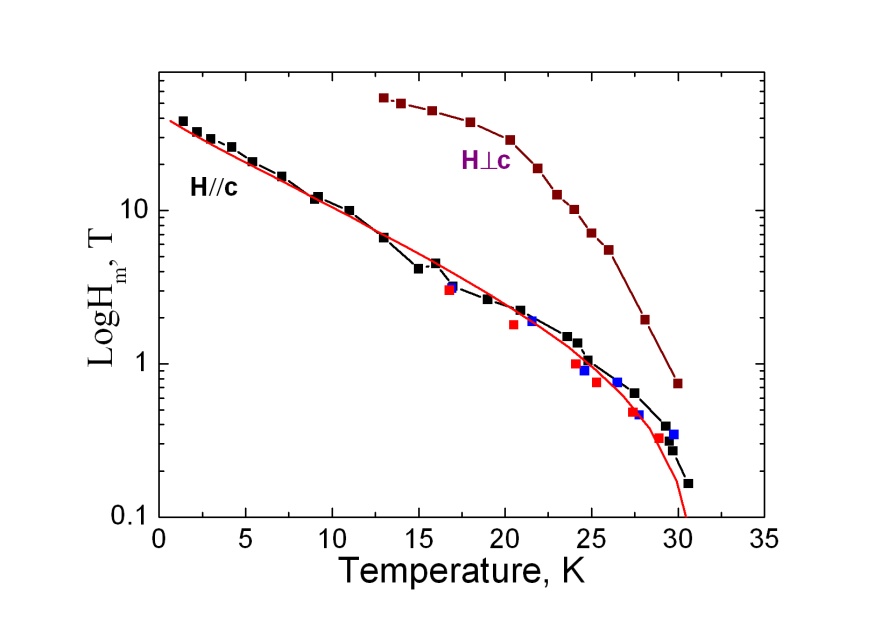
Fig.1. Temperature dependence of Hm(T) upper critical magnetic field in La1.65Sr0.45Cu-O4/ La2CuO4 heterostructures in a magnetic field perpendicular (the black dots) and parallel (the brown curve) to a 0.2 nm-thick two-dimensional superconducting layer in pulsed magnetic fields up to 56 T. The red and blue dots demonstrate the results in constant fields. The red solid curve shows the result of theoretical fitting in vortex melting model [1].
Theme 8.2. Interparticle Interactions and Collective Phenomena in Electron and Exciton Systems in Semiconducting Nanoctructures
Section II. "Physical sciences", subsection 8. "Actual problems of condensed matter physics, including quantum macrophycics, mezoscopy, nanostructure physics, spintronics, superconductivity". Programs of fundamental scientific researches for state academies of sciences in years 2013-2020
1. Transition from Classic to Specular Andreev Reflection at the Interface between a Superconductor and a Two-Dimensional Semimetal.
 The effect of Andreev reflection at the interface of a superconductor (S)
and a normal metal (N) permits charge transport through NS interface
under energies lower than a superconducting gap. In classic Andreev
reflection, a hole reflected from the interface remains in the
conduction band of a normal metal. However, in the systems which have
been actively investigated in recent years (graphene, Weyl
semimetals) the other process is possible: the hole appears in the
valence band, so it experiences specular reflection from NS interface
due to other mass sign. In our work, we have experimentally
investigated the process of Andreev reflection at the interface
between a classic, three-dimensional superconductor (niobium) and a
two-dimensional semimetal realized in CdHgTe/HgTe/CdHgTe wide quantum
well or InAs/GaSb two-layer system. We have discovered the transition
from classic (retro) to specular Andreev reflection. The transition
appears as a sharp increase of differential resistivity out of some
voltage range at NS interface which is defined by the spectrum of a
two-dimensional semimetal, see Figure. We have also investigated the
peculiarities of charge transport in specular Andreev reflection
leading to 1/n-periodic local extrema of differential resistivity of
a single NS contact. (A.A. Kononov, E.V. Devyatov, S.V. Egorov (associated with ISP SB RAS))
The effect of Andreev reflection at the interface of a superconductor (S)
and a normal metal (N) permits charge transport through NS interface
under energies lower than a superconducting gap. In classic Andreev
reflection, a hole reflected from the interface remains in the
conduction band of a normal metal. However, in the systems which have
been actively investigated in recent years (graphene, Weyl
semimetals) the other process is possible: the hole appears in the
valence band, so it experiences specular reflection from NS interface
due to other mass sign. In our work, we have experimentally
investigated the process of Andreev reflection at the interface
between a classic, three-dimensional superconductor (niobium) and a
two-dimensional semimetal realized in CdHgTe/HgTe/CdHgTe wide quantum
well or InAs/GaSb two-layer system. We have discovered the transition
from classic (retro) to specular Andreev reflection. The transition
appears as a sharp increase of differential resistivity out of some
voltage range at NS interface which is defined by the spectrum of a
two-dimensional semimetal, see Figure. We have also investigated the
peculiarities of charge transport in specular Andreev reflection
leading to 1/n-periodic local extrema of differential resistivity of
a single NS contact. (A.A. Kononov, E.V. Devyatov, S.V. Egorov (associated with ISP SB RAS))
2. Nonequilibrium Function of Two-Dimensional Electrons Distribution over Landau Levels under Microwave Radiation
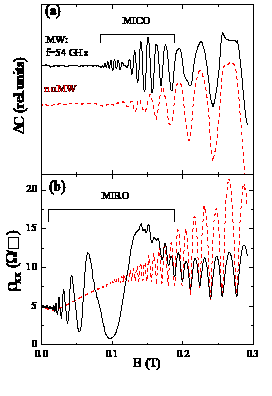
Fig. Microwave-induced frequencies f=54 GHz and magnetic oscillations of capacitance (MICO, panel a) and magnetoresistivity (MIRO, panel b). The red lines demonstrate quantum oscillations in the absence of radiation.
Microwave-induced magnetic oscillations of capacitance of a field-effect transistor with a two-dimensional electron system have been discovered. In contrast to all the known magnetic oscillations in electron transport occurring under radiation, the period of magnetocapacitance oscillations is determined by filling of two subbands of dimensional quantization, and only the positions of these oscillations strokes are set by radiation frequency. It is shown that capacitance oscillations are induced by redistribution of electrons over the subbands under the conditions of nonequilibrium filling of electron states oscillating by the energy. Thus, the appearance of the nontrivial nonequilibrium function of electrons distribution over the energy occurring under microwave radiation has been determined.
(Physical Review Letters, 2016, 117, 176801 - 1-6.)3. Magnetofermionic Condensate in a Two-Dimensional Electron System
Under excitation of long-lived triplet magnetoexcitons in a Hall insulator with high electron mobility, filling factor n=2, and low temperatures, Т < 1 K, a fundamentally novel collective state – magnetofermionic condensate – has been discovered. The condensed phase interacts coherently with an external electromagnetic field, possesses superradiant properties, and spreads over the surface of a two-dimensional structure over macroscopically large distances (>2 mm!, see Fig.) due to low viscosity. The discovered effects are the direct consequence of excitation in a nonequilibrium system of two-dimensional fermions with totally quantized energy spectrum of a magnetoexciton component having Bose nature.

Fig.1. Illustration of detection of magnetofermionic condensate spreading by lightguide probing
The left light guide is used for photoexcitation of the electron system. The right part made of two light guides is used to record magnetoexcitons spreading from the excitation spot. The graph shows temperature dependence of the recorded signal intensity (the number of spin magnetoexcitons reached the recording point) as the function of inverse temperature. In the point of transition to a superfluid phase the signal increases in a threshold way.
- L.V. Kulik, A.S. Zhuravlev, S. Dickmann, A.V. Gorbunov, V.B. Timofeev, I.V. Kukushkin & S. Schmult, Magnetofermionic condensate in two dimensions, Nature Comm. 7, 13499 (2016).
5. Spatiotemporal Chaos and Spontaneous Long-Range Ordering in Polariton Systems
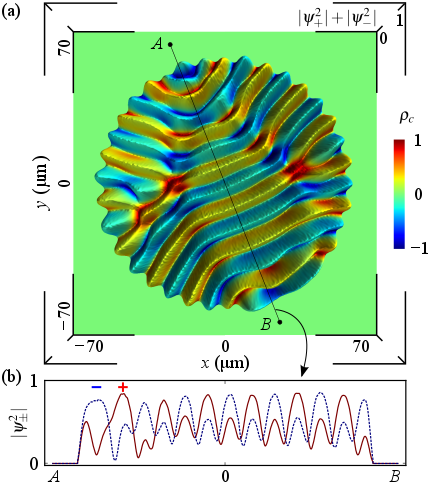 It is theoretically predicted that a nonequilibrium cavity-polariton
condensate formed under resonant optical driving can have
nonsteady
It is theoretically predicted that a nonequilibrium cavity-polariton
condensate formed under resonant optical driving can have
nonsteady
states in spite of strictly constant driving conditions. As a result,
a light wave transmitted through a microcavity exhibits periodic or
chaotic variation of its circular-polarization degree from +1 to -1 on
the timescale comparable to the polariton lifetime (tens of
picoseconds). Specifically, such states are characteristic
of quasi-zero-dimensional (0D) cavity micropillars. In 1D quantum wires,
the possibility opens up for self-organization of the condensate due
to spontaneous separation of spin-up and spin-down domains in the form
of a periodic strongly ordered structure. In 2D systems, the
long-range order is no longer "strong" but rather resembles a
turbulent fluid whose state can also be chaotic in space and time. The
considered phenomena are involved by a new channel of the
polariton-polariton scattering which appears in anisotropic cavities.
Fig.1. Typical example of the distribution of the field intensity and circular-polarization degree (shown by the color scale) formed in a homogeneous 2D cavity. Such states can be static or varying chaotically; in the latter case the Kolmogorov entropy (complexity) of the light wave transmitted through the cavity grows indefinitely with increasing lateral size.
S.S. Gavrilov Phys. Rev. B 94, 195310 (2016).
Theme 8.3. Self-Organization of Nanostructured Systems and Defect
Physics in Semiconductors and Dielectrics.
Section II. "Physical sciences", subsection 8. "Actual problems of condensed matter physics including quantum macrophycics, mezoscopy, nanostructure physics, spintronics, superconductivity".
Programs of fundamental scientific researches for state academies of sciences in years 2013-2020).
Section II. "Physical sciences", subsection 8. "Actual problems of condensed matter physics including quantum macrophycics, mezoscopy, nanostructure physics, spintronics, superconductivity". Programs of fundamental scientific researches for state academies of sciences in years 2013-2020).
Composite Probes for Investigation of the Systems with Topological Singularities in Electron Spectra
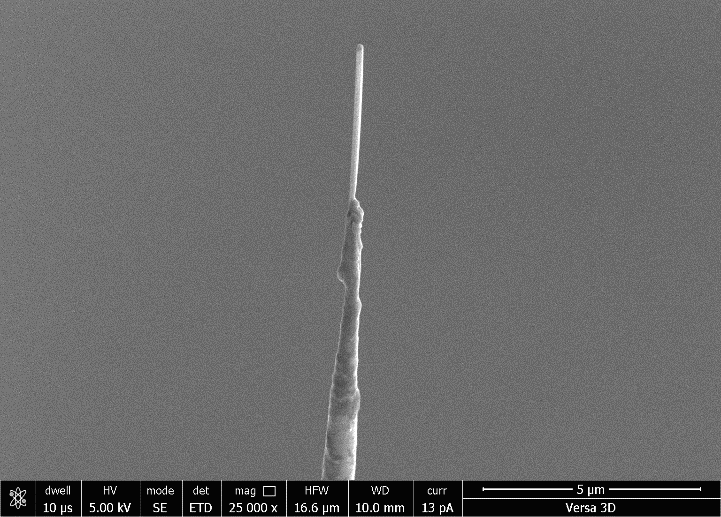

CTM composite probes of topological insulator whisker – Bi-Sb alloy – has been developed using focused ion beams technique. Atomic resolution has been obtained on Sb(111) surface using the probe. This demonstrates a high potential of such probes for investigation of the properties of topological systems.
3. Quantum Cryptography
The estimations of key transfer range through open space have been made for three different protocols: for BB84 and PTC (PhaseTimeCoding) protocols in the case of a single-photon source, and for RQKD protocol of relativistic quantum cryptography (RelativisticQuantumCryptography) in the case of attenuated laser radiation.
The systems of relativistic quantum cryptography turned out to be robust against to PNS and UM attack under any losses, and also to an attack with detectors blindning. In contrast to other system, the only factor limiting transfer range of private keys is dark noises of single-photon detectors. For this reason, it is possible not to use a strictly single-photon source for open space. Nevertheless, it is interesting to compare key transfer rate depending on the losses in a communication line for BB84 nonrelativistic protocols, a protocol with phase-time coding (PTC – PhaseTimeCoding) with a single-photon source, and RQKD protocol of relativistic quantum cryptography (RelativisticQuantumCryptography) with a nonsingle-photon source (weakened by laser radiation). It turns out that RQKD protocol provides guaranteed private key transfer at higher rate under greater losses than that for BB84 protocol with a strictly single-photon source. The longest range is provided by PTC protocol with a strictly single-photon source.
Theme 8.4. Phase Transitions, Structure (Atomic, Magnetic, Defect) and Properties of Crystals, Disordered and Composition Micro- and Nanosystems at Standard and High Pressure
Section II. "Physical sciences", subsection 8. "Actual problems of condensed matter physics including quantum macrophycics, mezoscopy, nanostructure physics, spintronics, superconductivity".
Programs of fundamental scientific researches for state academies of sciences in years 2013-2020
1. Phase Transitions in Amorphous and Nanocrystalline Materials
It is determined that the process of composition separation leading to the formation of amorphous regions characterized by different type of a short-range order occurs in an amorphous phase during deformation. Earlier such changes have been observed at temperature increase only. Radii of the first coordination spheres of the formed amorphous phases depend on a chemical composition of the alloy and deformation degree. Separation degree under deformation is slightly lower than that after heat treatment. For instance, in Al88Ni6Y6 alloy radius of the first coordination sphere changes from 0.289 nm (initial amorphous phase) to 0.286 (Y-depleted amorphous phase) and 0.297 nm (Y-enriched amorphous phase); in Al87Ni8La5 alloy radii of the first coordination spheres of new amorphous phases are 0.298 nm (La-enriched amorphous phase) and 0.254 nm (Ni-enriched amorphous phase). The size of nanocrystals formed in a heterogeneous (two-phase) amorphous alloy is less than that of nanocrystals formed in a homogeneous amorphous phase that is important for obtaining high-strength materials. (A.Aronin, D.Matveev, E.Pershina, G.Abrosimova “The effect of changes in amorphous phase structure on structure forming upon crystallization” J. All. Comp., in press).
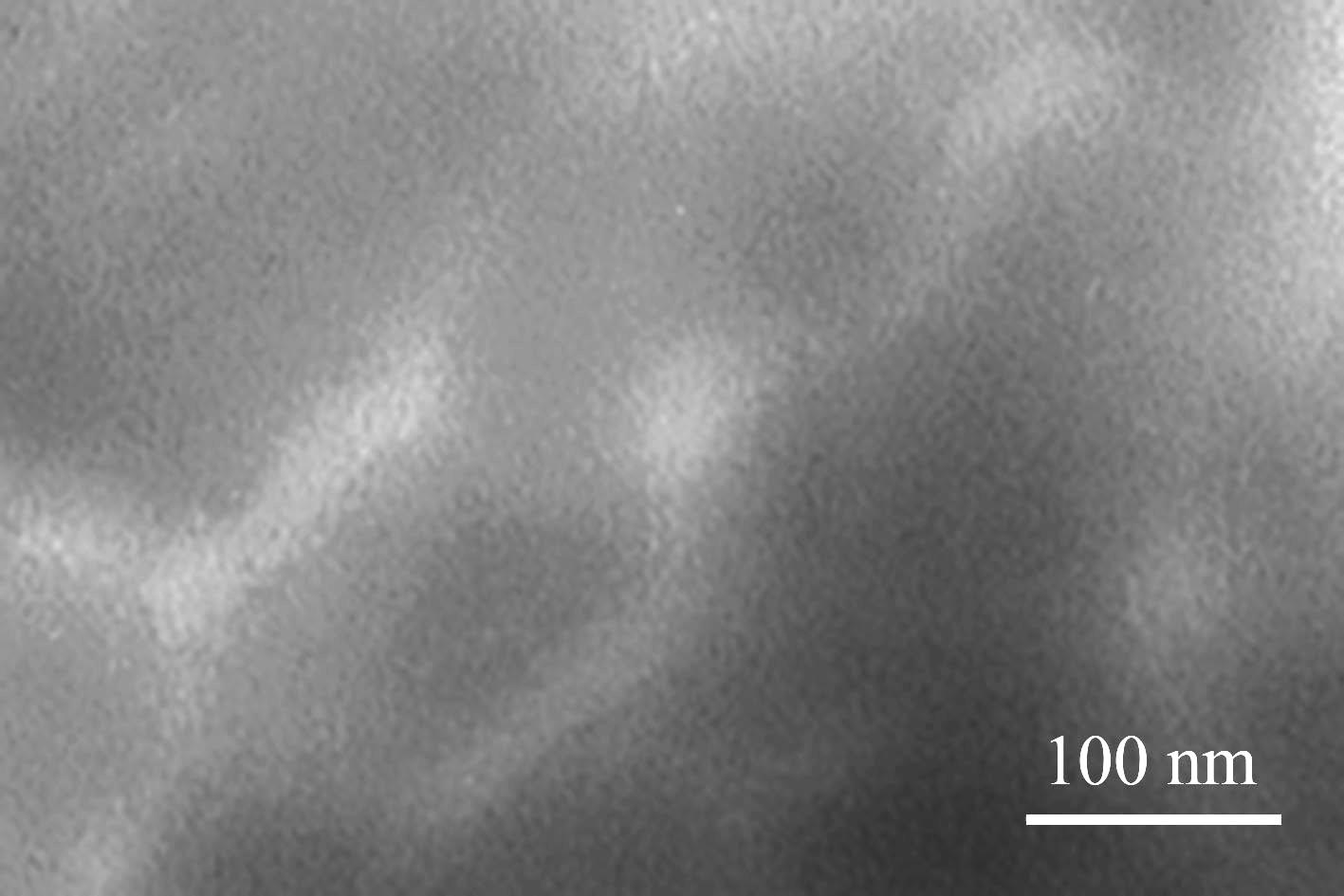 |
 |
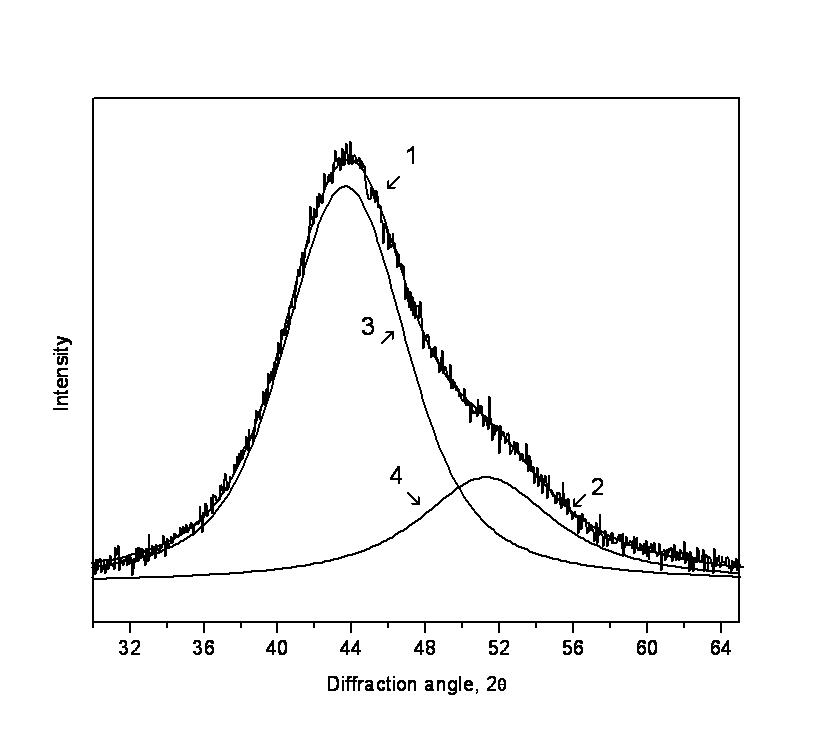 |
| a | b | c |
Microstructure (a), electron diffraction pattern (b) and X-ray diffraction pattern (c) of Al87Ni8Gd5amorphous alloy containing amorphous regions of different chemical composition
2. Extension of the Temperature Range of the High-Pressure Quenching Technique from 400 to 800\B0 C: the First Results for the Mo-H System
T-P diagram of the Mo-H system is investigated at P <= 6 GPa and T <= 800 \B0C using the quenching technique developed at ISSP RAS. The stability range of the low-temperature hcp (ε) MoH1.1 hydride [1] is found to increase with pressure and reach 800 °C. Earlier, phase diagrams of the metal-hydrogen systems at temperatures higher than 450–500 °С and pressures of the GPa range have only been investigated by the group of Y. Fukai (Japan) using in situ X-ray diffraction. The formation of a high-temperature fcc (γ) MoH hydride at T> 480–570 °C reported by that group [2] is not confirmed, which invalidates one of their basic findings that all hydrides of transition metals acquire a fcc structure at high temperatures and pressures. (J. Alloys Compounds672 (2016) 623-629.)
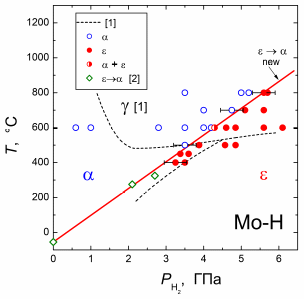
Fig.1. T-P diagram of the Mo-H system. The dashed lines are the boundaries between the fields denoted α (diluted solid hydrogen solutions in bcc molybdenum), ε and γ (hcp and fcc Mo hydrides) according to [2]. The diamonds are points of the αγ transition according to [1]. The open and filled circles show formation conditions of the α and ε phases in quenching experiments. The solid straight line is the boundary between the α and ε phase fields constructed in the present work.
[1] V.E. Antonov et al., Dokl. Akad. Nauk SSSR 248 (1979) 635.
[2] Y. Fukai et al., Mater. Trans. 44 (2003) 1359.
Theme 9.1. Heat-Resistant Materials for New Equipment.
Section II. "Physical sciences", subsection 9. "Material physics: new materials and structures including fullerenes, nanotubes, graphenes, other nanomaterials, and also metamaterials (in the fields of physics and technologies of new functional materials for effective power conversion". Programs of fundamental scientific researches for state academies of sciences in years 2013-2020
1. Sapphire Terahertz Photonic Crystalline Waveguides (THz PC waveguides)
Terahertz photonic crystalline waveguides based on shaped sapphire crystals have been developed and produced for the first time. The results of experimental study of terahertz pulse radiation propagation in the multichannel waveguides have shown the possibility to use them for guiding the THz waves in multimode regime with the minimal dispersion in frequency range of 1.0–1.55 THz and the minimal power extinction coefficient of 0.02 dB/cm at 1.45 THz [1]. The obtained results demonstrate the capabilities of the developed waveguides to be used for creation of for creation of THz technologies of quality control, non-destructive testing and biomedical diagnostics. G.M.Katyba, I.A. Shikunova, V.N. Kurlov (in collaboration with Bauman Moscow State Technical University)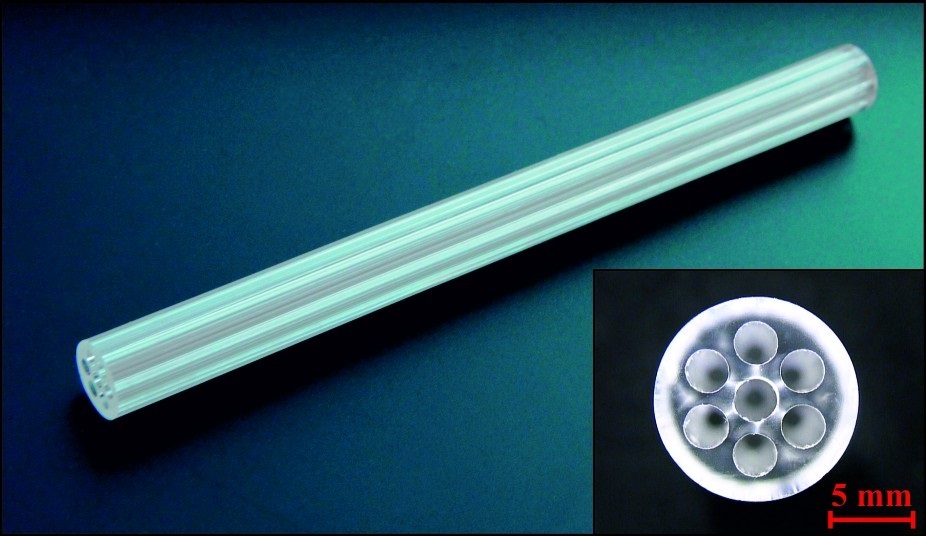 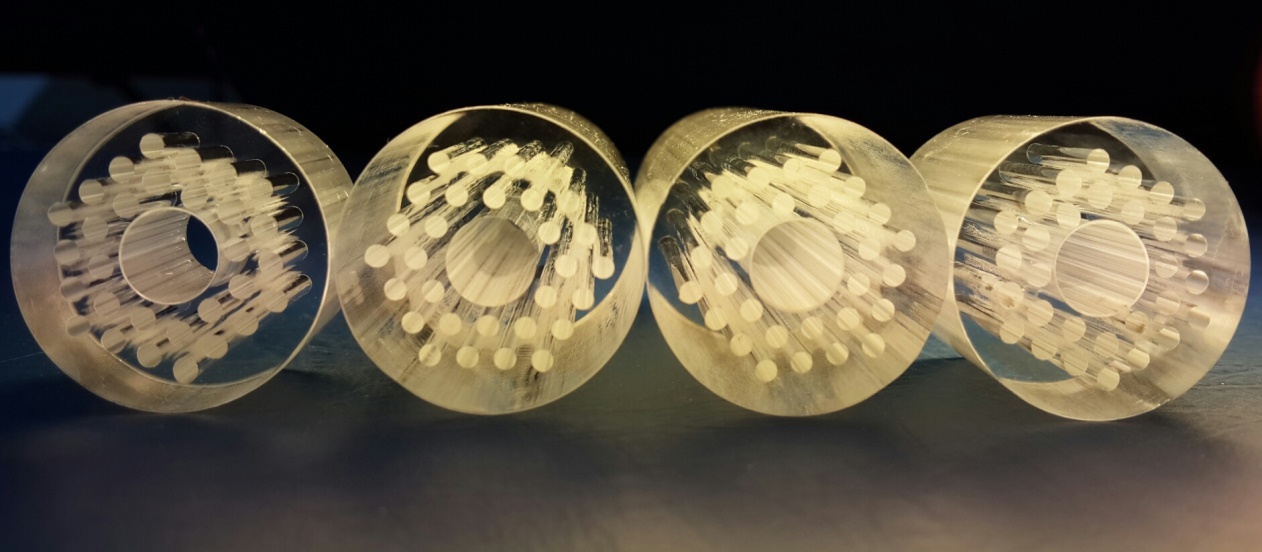 |
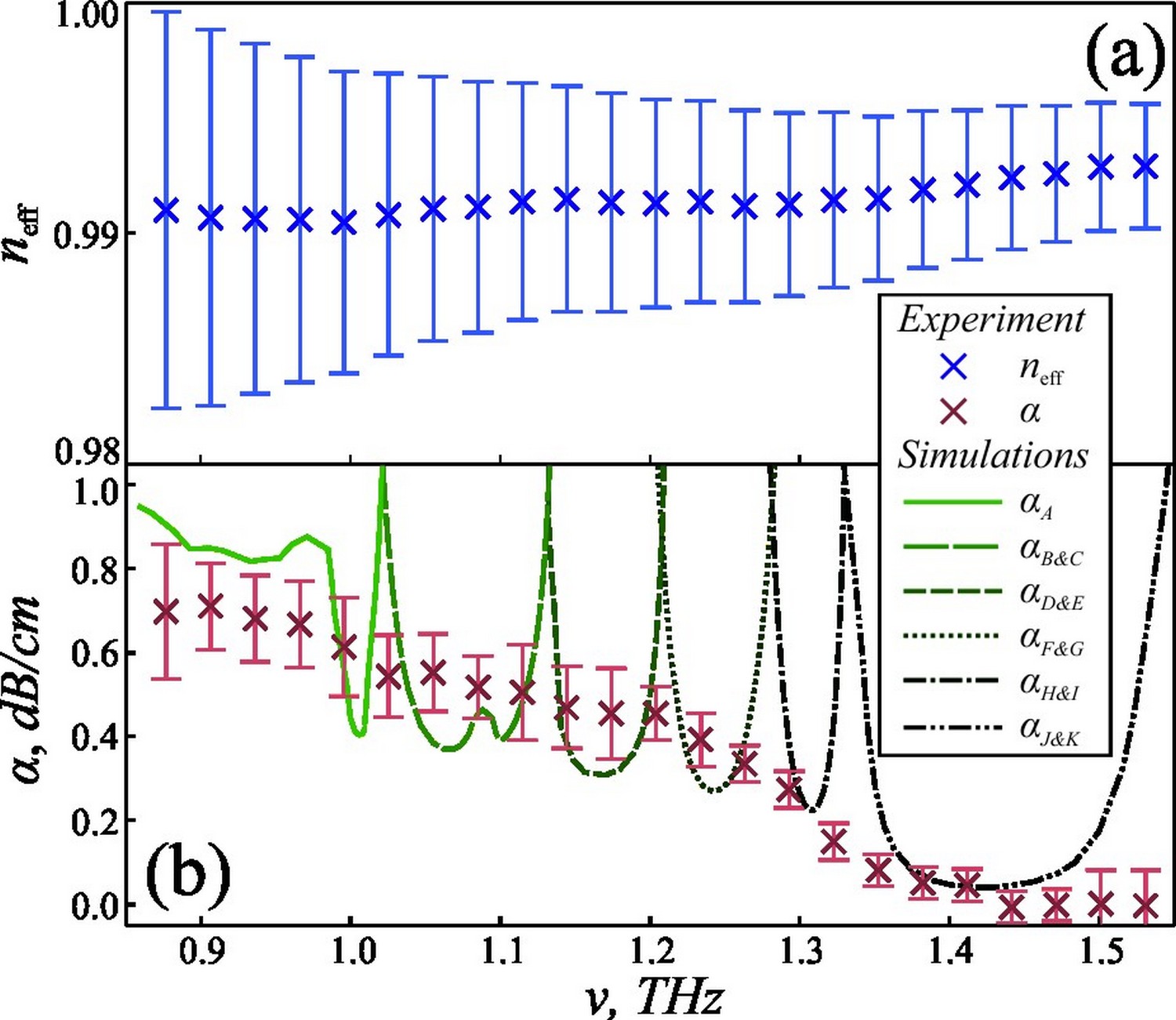 |
Fig. Digital photo of sapphire THz PC waveguides at the left. Experimental results of studying the THz waveguiding in the shaped crystal: (a), (b) demonstrate experimental effective mode index ??f? and power extinction coefficient α, respectively at the right.
[1] IEEE Transactions on Terahertz Science and Technology 6(4), 576-582 (2016).
Theme 9.2. Novel Functional Materials for Microelectronics, Optoelectronics and Effective Power Conversion.
Section II. "Physical sciences", subsection 9. "Material physics: new materials and structures including fullerenes, nanotubes, graphenes, other nanomaterials, and also metamaterials (in the fields of physics and technologies of new functional materials
for effective power conversion".
Programs of fundamental scientific researches for state academies of sciences in years 2013-2020
1. Development of a Standard Sample for Ensuring Uniformity of Optical Measurements of Zeta Potential
Zeta potential is the main stability index of colloid systems in liquid media. Colloid systems are used in a lot of fields of science and engineering such as, for instance, medicine, pharmaceutics, chemical industry, mineral dressing, water purification, soil cleansing, and many others. Certified standard materials are necessary to increase the accuracy and correctness of measurements. At present European and American standard samples are used for these purposes because of the absence of domestic materials. For their import substitution, ISSP RAS and VNIIOFI have developed domestic standard samples (SS) based on aqueous suspension of silicon dioxide nanoparticles synthesized by heterogeneous hydrolysis of tetraethyl orthosilicate (TEOS) using the environmentally friendly catalyst (L-arginine). We have obtained silicon dioxide particles with controlled electrokinetic potential, exhibiting the values of zeta potential (ZP) in a range -30 mV ÷ - 50 mV (Fig.). G.A. Emelchenko, V.M. Masalov, N.S. Sukhinina (in collaboration with VNIIOFI, Moscow)
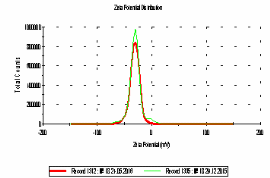
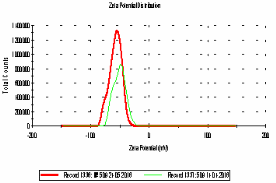
Theme 12.1. Nonlinear Processes in Nanocomposite Magnetic Films, Liquid-Crystal Materials, on the Surface and in the Volume of Quantum Liquid.
Section II. "Physical sciences", subsection12. "Modern problems in radiophysics and acoustics including fundamental principles of radiophysical and acoustic methods of communication, location and diagnostics, study of nonlinear wave effects”. Programs of fundamental scientific researches for state academies of sciences in years 2013-2020
1. Instability of the Free Surface of Superfluid Helium Induced by a Steady Heat Flow in Liquid Volume.
Instability of the surface of superfluid helium-II caused by relative motion of
normal and superfluid components along the surface has been studied
in present work. The experiments have been performed in the open at
the top container, partially filled with liquid helium, with the
sizes of 30x24 mm and the height of
5 mm. A steady counterflow
of the components was induced by a steady heat flow in liquid volume,
passing from a film heater. The heater was installed on container
wall. Two orifices with a diameter of 2.5 mm were made on this and
the opposite walls for free percolation of the normal component from
the container. Stability of the surface was monitored by the power of
a reflected laser beam. It has been determined that the initially
flat surface loses its stability when heat flow reaches some critical
value. Figure shows the dependence of critical value of a heat flow
on liquid temperature. The dots are the experimental data obtained
under different times of power scanning for the heater; the solid
curve is calculation within the Korshunov model [1, 2].

It is assumed that instability of the Kelvin-Helmholtz type develops on the surface when the relative velocity of the normal and superfluid components reaches some critical value. The difference between the experimental data and the theoretical curve is caused apparently by turbulence development in liquid helium. After the surface has transited to the unstable state, wave turbulence develops on the surface in a frequency range between 10 Hz and 5 kHz. (I. A. Remizov, A.A. Levchenko, L.P. Mezhov-Deglin, J.LTP – 2016. – V. 185. – I. 3. – P. 324–338).
1. S.E. Korshunov, Europhys. Lett. 16, 673 (1991)
2. S.E. Korshunov, JETP Lett. 75, 423 (2002)
2. Two-Dimensional Hexagonal Structure Formed by Ordered Topological Defects in Smectic Nanofilms
The formation of a two-dimensional hexagonal structure of ordered point topological defects with topological charge S=+1 and intersecting walls has been observed in polar smectic nanofilms (see Fig.1). Orientation of molecular tilt in two-dimensional layers is opposite in neighboring hexagonal cells. A hexagonal ordering of topological defects has been predicted theoretically, but it has not been observed so far. A hexagonal structure is formed by self-organization of smectic islands of larger thickness in two-dimensional smectic nanofilms. The method used for obtainment of structures of topological defects can be used for obtainment of nanofilms with a complex two-dimensional ordering (P.V. Dolganov, V.K. Dolganov Phys. Rev. E, 2016).
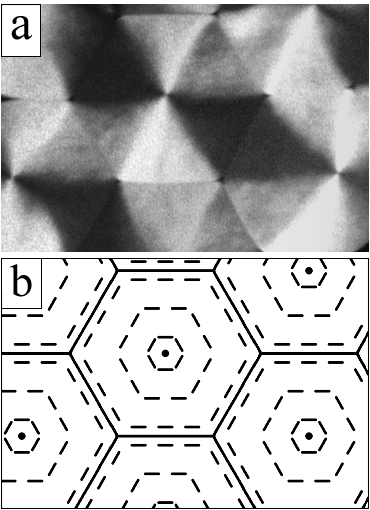
Fig.1. (a) A hexagonal structure formed by point topological defects and intersecting walls. The image is obtained by depolarized microscopy in reflected light. The orientation of molecule tilt plane in a hexagonal structure is shown schematically in Fig.1(b). The horizontal dimension of the image is 167 \B5m.




